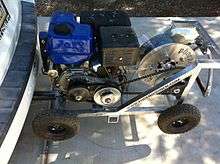Winch
A winch is a mechanical device that is used to pull in (wind up) or let out (wind out) or otherwise adjust the "tension" of a rope or wire rope (also called "cable" or "wire cable"). In its simplest form it consists of a spool and attached hand crank. In larger forms, winches stand at the heart of machines as diverse as tow trucks, steam shovels and elevators. The spool can also be called the winch drum. More elaborate designs have gear assemblies and can be powered by electric, hydraulic, pneumatic or internal combustion drives. Some may include a solenoid brake and/or a mechanical brake or ratchet and pawl device that prevents it from unwinding unless the pawl is retracted.
Applications

The rope is usually stored on the winch, but a similar machine that does not store the rope is called a capstan. When trimming a line on a sailboat, the crew member turns the winch handle with one hand, while tailing (pulling on the loose tail end) with the other to maintain tension on the turns. Some winches have a "stripper" or cleat to maintain tension. These are known as "self-tailing" winches.[1]
Winches are frequently used as elements of backstage mechanics to move scenery in large theatrical productions. They are often embedded in the stage floor and used to move large set pieces on and off.
Winches have recently been fabricated specifically for water and snow sports (e.g. wakeboarding, wakeskating, snowboarding, etc.). This new generation of winches is designed to pull riders swiftly across a body of water or snow, simulating a riding experience that is normally supplied by a boat, wave runner, or snow mobile.
Lever Winch
Lever winches also commonly known as Tirfors™ or Griphoists™, are winches that use self-gripping jaws instead of spools to move rope or wire through the winch. Powered by moving a handle back and forth, they allow one person to move objects several tons in weight.
Types of winches
Snubbing winch

This is a vertical spool with a ratchet mechanism similar to a conventional winch, but with no crank handle or other form of drive.[2] The line is wrapped around the spool and can be tightened and reeled in by pulling the tail line, the winch takes the load once the pull is stopped with little operator tension needed to hold it. They also allow controlled release of the tension by the operator using the friction of the line around the ratcheted spool. They are used on small sailing boats and dinghies to control sheets and other lines, and in larger applications to supplement and relieve tension on the primary winch mechanisms.
Wakeskate winch
Wakeskate winching is a growing hobby for many watersports enthusiasts. The winch consists of an engine, spool, rope, handle, frame, and some sort of simple transmission. The person being towed walks (or swims) away from the winch and pulls out all of the rope. When the winch is engaged, it pulls the boarder usually between 15 to 25 miles per hour (24 to 40 km/h). The winch may be mounted on the trailer hitch of a vehicle, set into the ground by stakes, or tied to a tree. These winches have been modified for use by skiers and snowboarders in cities.
Glider winch
Gliders are often launched using a winch mounted on a trailer or heavy vehicle. This method is widely used at European gliding clubs, as a cheaper alternative to aerotowing. The engine is usually a large Petrol, LPG or diesel, though hydraulic fluid engines and electrical motors are also used. The winch pulls in a 1,000 to 1,600-metre (3,000 to 5,500 ft) cable, made of high-tensile steel wire or a synthetic fibre, attached to the glider. The cable is released at a height of about 400 to 700 metres (1,300 to 2,200 ft) after a short, steep climb.[3]
Air Winch
An air winch, sometimes known as an air hoist or air tugger, is an air-powered version of a winch. It is commonly used for the lifting and the suspension of materials. In the oil and gas, construction, and maritime industries, air winches are frequently preferred to electric, diesel, and hydraulic winches because of their durability, versatility, and safety.[4][5]
History
The earliest literary reference to a winch can be found in the account of Herodotus of Halicarnassus on the Persian Wars (Histories 7.36), where he describes how wooden winches were used to tighten the cables for a pontoon bridge across the Hellespont in 480 B.C. Winches may have been employed even earlier in Assyria. By the 4th century BC, winch and pulley hoists were regarded by Aristotle as common for architectural use (Mech. 18; 853b10-13).[6]
The yacht Reliance, American defender of the 1903 America's Cup, was the first racing boat to be fitted with modern winches below decks, in an era when her competitors relied on pulley systems (block and tackle).
See also
References
- ↑ Mark Smith. The Annapolis Book of Seamanship. 1999 Simon & Schuster
- ↑ Maritime Industry Dictionary definition: m-i-link.com
- ↑ Piggott, Derek (1977). Understanding Gliding. Morrison & Gibb Ltd, London & Edinburgh. ISBN 0-7136-1640-7.
- ↑ "What is an Air Winch?". Falck Productions. Retrieved 20 June 2012.
- ↑ "Overhead Hoists, 1926.554". U.S. DOL, OSHA. Retrieved 20 June 2012.
- ↑ J. J. Coulton, "Lifting in Early Greek Architecture," The Journal of Hellenic Studies, Vol. 94. (1974), pp. 1-19 (12)
External links
| Look up winch in Wiktionary, the free dictionary. |
| Wikimedia Commons has media related to Winches (sailboats). |
- Arctander, Erik H. (May 1995). "Battery-powered winches". Popular Science: 103–105.
- Difference between planetary, worm, and spur gear winches